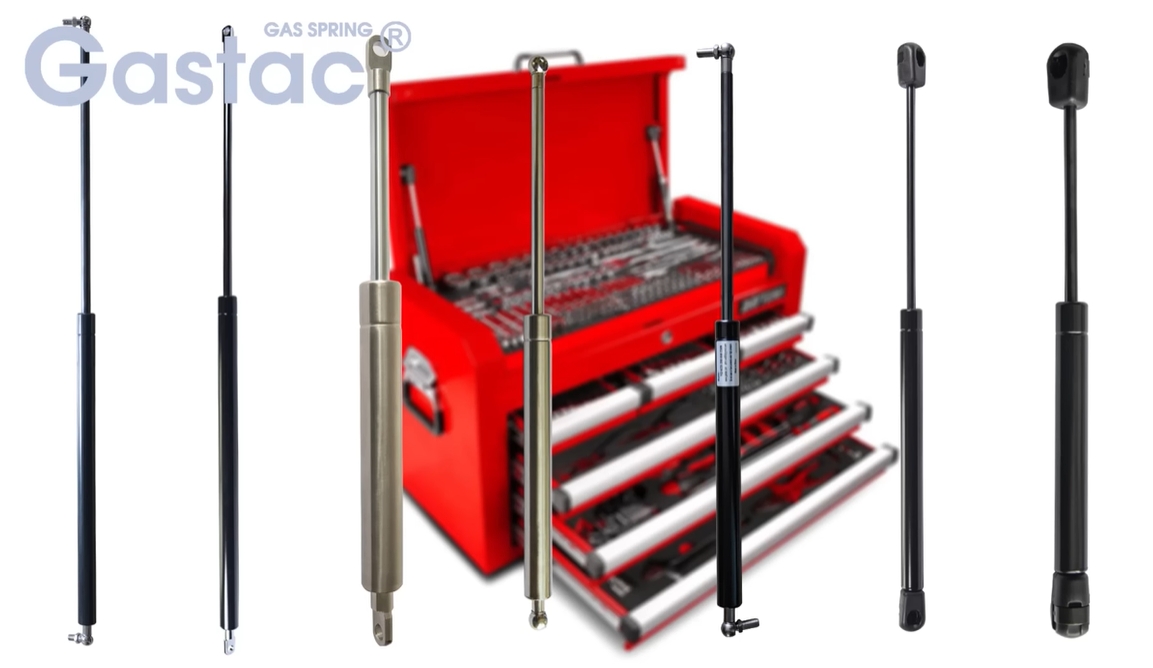Tool Box Shocks: In a busy construction site, a crew is loading their tools into a truck when the toolbox slams shut, causing tools to rattle and nearly spill out. Frustration mounts as the team struggles with the heavy lid. Just then, a worker pulls out a GASTAC Truck Tool Box Shock, quickly installing it. With a smooth, controlled motion, the toolbox closes effortlessly, keeping tools secure. The crew cheers, realizing their workflow just got a serious upgrade, thanks to this innovative solution.

GASTAC, a leading Chinese gas spring strut manufacturer, offers advanced production technology and a skilled manufacturing team. For custom tool box shocks, contact sales@gastac.com. For standard tool box struts specifications, visit the GASTAC online store for easy purchasing and reliable solutions.
Tool Box Shocks Gas Struts Size Chart
GASTAC offers a Tool Box Shocks Gas Struts Size Chart featuring a wide range of common sizes for easy selection. Each option includes a detailed specification sheet, helping you find the perfect fit for your needs. Reliable, durable, and user-friendly, GASTAC makes choosing the right gas strut simple and efficient.
| Product | Rod Ø | Tube Ø | Extended Length | Compressed Length | Stroke | Force |
| GT8180700110 | 8mm | 18mm | 7 Inch | 5.12 Inch | 1.88 Inch | 10-110 Lbs |
| GT8180750110 | 8mm | 18mm | 7.5 Inch | 5.25 Inch | 2.25 Inch | 10-110 Lbs |
| GT8181000110 | 8mm | 18mm | 10 Inch | 7.10 Inch | 2.90 Inch | 10-110 Lbs |
| GT8181200110 | 8mm | 18mm | 12 Inch | 8.03 Inch | 3.97 Inch | 10-110 Lbs |
| GT8181489110 | 8mm | 18mm | 14 Inch | 8.90 Inch | 5.10 Inch | 10-110 Lbs |
| GT8182000150 | 8mm | 18mm | 20 Inch | 12.13 Inch | 7.87 Inch | 50-150 Lbs |
How to Measure Tool Box Shocks?
To accurately measure and calculate the specifications of the tool box shocks, follow the steps detailed below:
1.Extend the Tool Box Shocks(L):
- Fully extend the shocks so that it reaches its maximum length.
- Measure the distance from the center of one eyelet (or mounting point) to the center of the other eyelet. This is the extended length of the struts.
2.Compress the Tool Box Shocks(A):
- Fully compress the struts to its shortest length.
- Again, measure the distance from the center of one eyelet to the center of the other. This is the compressed length of the struts.
3.Calculate the Tool Box Shocks(S):
- Subtract the compressed length from the extended length to determine the stroke length.
- The stroke length is the distance the struts travels between its fully compressed and fully extended positions.
- Stroke Length=Extended Length−Compressed Length
4.Measure Tool Box Shocks Diameter(d/D):
Record your gas strut diameter as Rod Diameter/Canister Diameter. For example, if the rod diameter is 8mm and the tube diameter is 18mm, the strut diameter should be noted as 8/18 (For more information, please go to the expert page).

measure tool box shocks, which is essential for selecting or replacing struts in your tool box. Proper measurement ensures that the struts will perform correctly, providing adequate support and function.
5.Newton Meters or Force
To determine the force of the gas strut (measured in Newton meters or Nm), there are a few methods:
- Check the existing toolbox gas strut: If you’re replacing an existing strut, the force may be printed on the side.
- Use a weighing scale: Compress the strut against the scale to measure the force required.
- Refer to product specifications: For new applications, consult the product specifications to find the required force.
GASTAC specializes in producing high-quality toolbox shock built to last. With a focus on durability and precision, we use premium materials and advanced manufacturing techniques to ensure each shock delivers smooth, consistent performance. Whether for heavy-duty trucks or industrial equipment, GASTAC shock are the ideal choice for reliability and longevity.
How to fit gas struts to tool box?
Here’s a four-step guide to fitting gas struts to your toolbox for optimal performance:
- Open the Lid to the Desired Angle: Position the toolbox lid at the angle you want it to open to.
- Attach the Cylinder End: Secure the cylinder end of the gas strut to the lid, following the fitment and pressure guide provided.
- Attach the Shaft End: With the lid still open, swing the shaft end of the gas strut toward the fixed mount at the center, and securely attach it.
- Test the Lid Movement: Ensure the lid opens and closes smoothly without any restrictions.
Two mounting orientations are available: ‘Push Up’ and ‘Flip Over.’ Regardless of the orientation, the component should always be mounted with the “rod down” in the fully closed position to ensure proper seal lubrication.
Following these steps will help ensure a proper and efficient fit for your gas struts.
GASTAC Tool Boox Shocks
GASTAC gas springs are crafted to optimize tool box functionality, providing smooth and controlled lid and compartment operation. Designed to offer dependable support for a variety of tasks, they prioritize user safety and ease of use. Made from high-grade materials, these springs are built to last and perform consistently, even in challenging conditions. Whether you’re opening or closing lids or securing your tools, our gas springs are tailored to meet the specific demands of tool boxes, delivering a reliable and effective performance solution.


